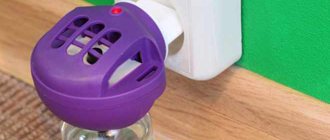The shapeless tangle of wires from various devices that lives under the desktop is affectionately called by computer scientists as cable Cthulhu. Sometimes it grows to such a size that trying to untangle it is reminiscent of fighting the undead: you pull out one “tentacle”, and ten more follow it, winking with the red light of the surge protector. A smaller tangle often forms somewhere in a drawer of chargers, USB cables and mini headphones. To avoid having to “expel Cthulhu,” you just need to learn how to properly store wires. More precisely, not correctly, but conveniently.
Modern, neat, technologically advanced
Do you know how to determine that the owners of an apartment paid a tidy sum for renovations? Everything is simple - there are no protruding wires visible anywhere. We thought about how to hide them at the design stage.
One of the useful features is a USB socket in the desk drawer. It turns out to be a place for recharging gadgets, hidden from the picky eye. Convenient, beautiful, functional - and no wires in sight!
Stand for charging phones and tablets
For those who have a large number of different gadgets in their home that regularly need recharging, you can organize a place for this in your bedside table. The cabinet easily accommodates a hidden charging station and many devices. This is a practical solution to the issue of neatly placing wires in the interior. Drawers or hanging shelves can easily be equipped with sockets that allow you to easily charge devices.
Convenience for $1
To prevent the wires from getting tangled, each of them should have its own place.
“Parking” for cables can be organized in several ways:
- buy special rubber, silicone or plastic holders;
- use regular office clips;
- make cuts in a heavy piece of wood and insert cables into them.
This storage option is worth choosing for those extension cords, cables and chargers that you use every day.
Everyone has a lot of wires, cords, chargers for gadgets (phones, players, cameras, navigators, etc.). And often this category of things, compared to such things as clothes, shoes, accessories, is in complete disarray. Our new author, professional space organizer Nadezhda Avvakumova, has already started talking about the practically “forbidden” -
cleaning wires and various other male devices. In this article we will continue the topic and look at several ways to store and organize wires, cords, and chargers.
Boxes
Boxes, be they cardboard or plastic, are a great place to store anything. And if you think through their internal space wisely, it will be a good idea to organize all the wires, cords and chargers in the house. Here are a couple of ideas on how to do this:
If you divide a simple box into compartments using cardboard, label each cell and put the wires there, then you and your household will not have any difficulty finding the one you need. You can even allocate a separate drawer for some gadgets, as Eteri did, giving the name to one of them – “Computer Accessories”. The main thing is to send the cord back to its cell after use. No time to do handmade things? Our laundry organizers with many small compartments are also great for storing wires.
A budget and environmentally friendly option is to make in toilet paper tubes or cardboard sleeves . To make them look nice, decorate them with decorative tape or cover them with paper. It will be possible to give a second life to the cups . Any kind will do - plastic, plastic. Simple, convenient and budget-friendly.
The box can also be used as storage for phone chargers. Make small holes in the side walls. On one side there will be forks that you can plug into a tee or socket, and on the other there will be a plug. Such a box can become a decorative element.
But an important note - it's not entirely safe. An alternative can be special boxes. So, all gadgets that require additional network connection will not create chaos. This primarily applies to long cables that endlessly curl and hang from the desktop and create an unkempt appearance.
Organizers
Organizers do not take up much space and allow you to keep some important things, such as headphones and charging cable, safe and sound.
For needlewomen - a couple of ideas on how to sew pockets and cases for wires and chargers.
There are many options for hanging organizers . You can store everything you want in the pockets, even the TV remote control.
An indispensable accessory is travel organizers . They can be used both when traveling and for storing wires at home.
A budget option is to put infrequently used cords in a cosmetic bag , as Elena does . Since rarely does anyone use various wires in the house, they are stored with store-bought wire. Another organizer for transporting cosmetics Julia for storing wires . It’s beautiful - and you can see what’s there, but the only drawback, perhaps, is that “no one puts anything back.”
Hooks
For those who are too lazy to put wires in organizers, take them out, and then put them back in place, there is a solution - try hanging them on hooks and holders. If you wish, you can even install them away from view, for example, on a cabinet door.
How to secure wires for convenient storage
If you have a specially designated box for wires, then no matter how carefully you try to fold them, they will definitely get tangled together. The following organization methods will help solve this problem, and your drawer will always have order and extra space:
Binders (stationery clips). Easy to attach, easy to remove. It can be used for fastening wires both at the workplace and in a box, like Anastasia’s.
Those who prefer store-bought options now have clips and holders for compact storage and placement of large cables and wires.
Rubber bands (for hair, for creating children's bracelets, for money) are very convenient and affordable. Evgeniya uses them to store cords and chargers, and Anna additionally wraps them with mesh and stores them in a container.
Special Velcro tapes will help you tidy up tangled wires in your workplace.
Plastic ties . There are disposable and reusable ones on sale. They will be useful for collecting wires and cables scattered throughout the house, as in the example in the photo from my colleague Elena .
A budget option is to wrap the wires with self-adhesive colored tabs , so you can easily find the one you need.
Ideas on how to hide wires in the house
How to make sure that the wires at the computer desk do not create chaos? Very simple! Use one of the ways to fasten them above!
And to ensure that the chargers are in the same place, organize their storage in one of the drawers of the chest of drawers.
Disguising wires can also be a highlight of your decor!
What tricks and ideas do you have for storing wires, cords and chargers? We are very interested to know! VKontakte , Facebook and Instagram groups !
Everything unnecessary is out of sight
If the socket in the desk drawer has not yet started, but your soul is drawn to minimalism, there is an alternative solution.
What is missing in your interior is a special box with slots. Inside you can store a surge protector (extension cord) along with the countless wires that come from it. Forks, connectors will peek out of the slots or holes - in general, everything that ends up with hidden wires.
We recommend: How to properly store bananas so that they don’t turn black?
Homemade boxes
A variety of decorative boxes are perfect for hiding unsightly chargers and keeping your home tidy. There are already special boxes on sale with special holes, or you can order such a wooden accessory, made according to an individual sketch, taking into account the required dimensions of the product. A wide selection of colors and dimensions will ideally fit into any interior and even become its decoration.
Strategic reserve
In almost any home there will be devices and wires that are used very rarely: spare cables, extension cords, chargers from “previous” phones, garlands, some strange wiring that was included with the gadget... You never know what else! It is better to store all this stuff in one place - suddenly a miracle happens and some of it is still useful.
This is exactly why organizers were invented:
- handbags and briefcases;
- boxes with sections;
- hanging canvases with pockets.
Craftsmen, of course, are ready to offer a lot of homemade options. Everything goes into use - from shoe boxes and pieces of chintz to toilet paper rolls.
It is better to sign each wire or cable that is sent for long-term storage: after 3-4 years you are unlikely to immediately remember what it is intended for.
How to store wires and chargers so they don't get tangled
Cables get tangled when kept cluttered. Thin wires from headphones and chargers suffer greatly. They often break off and the insulation deteriorates. Result: replacement is required.
Do you keep your chargers and cables in order?
Not really
Storage rules:
- keep separately. We try not to throw them into one pile;
- we remove the excess. It's time to conduct an audit, throw away unused, old, non-working chargers. When purchasing a new phone, tablet, or fitness bracelet, they will not be needed;
- fold it carefully. Do not twist or bend, do light winding.
To store various wires, charges, and cables, special organizers, clamps, staples, and fasteners are used. Many accessories are easy to make with your own hands from scrap materials.
Other built-in station options
Depending on the style of the interior, your own preferences, capabilities and imagination, you can come up with many options for solving the issue of placing charging stations in hidden places. For example, built-in devices are not conspicuous and perform their function perfectly. Stylish hanging baskets will perfectly fit watches, headphones, mobile phones and small tablets - equipping such an original charging place will not require large financial expenditures.
© — when copying materials, an active link to the site is required!
Rubber
4. Most likely, you won’t have the required amount of elastic at home; you’ll have to go to a fabric store to get it.
There you can choose a ribbon of any color and width. Calculating the required length is very simple:
- divide the length of the base by the width of the tape - we get the number of vertical stripes (we take into account only whole stripes);
- multiply the number of stripes by the width of the base and multiply the resulting length by two (the stripes will encircle the frame on both sides);
- Now we similarly divide the width of the base by the width of the tape - we get the number of horizontal stripes (we take into account only whole stripes);
- multiply the number of stripes by the length of the base and multiply the resulting length by two (the stripes will encircle the frame on both sides);
- we add the two numbers that were obtained in the second and fourth steps and get the required length of the tape.
5. Now the elastic band needs to be cut into strips (vertical and horizontal). We have already counted the number of stripes, the length of the vertical ones is equal to twice the width of the base, and the length of the horizontal ones is twice the length of the base. In other words, each strip should encircle the frame without overlapping.
6. The most painstaking process is sewing rings from strips. Pre-singe the edges of the tape on the fire and you can start making rings.
We make a small overlap of 3-4 mm. and sew the ribbon together with a ring. You can ask your wife for help, especially if she has the skills to operate a sewing machine.
Children's bucket for storing bathroom accessories
Does your child love to swim? Then your bathroom most likely contains toys that a young sailor usually dives and plays with. Where to store all these boats, numerous soldiers, rubber duckies and dolls? The most convenient way is to put all the toys in a children's bucket, which is usually used only in the sandbox.
The bucket can simply be placed on a shelf or hung on a hook. If the bucket is made of iron, it can be painted to match the color of the bathroom design, and it will become an integral part of the interior. A plastic bucket can be decorated with stickers or decals.
If you have very little space in the bathroom or you want to create an original design, you can even store toothbrushes and toothpaste in a children’s bucket.
Lifehacks on how to quickly tidy up your desktop
Organizing your workspace isn't just about tidying up the ubiquitous cables. It is important to maintain your desktop in perfect order, because... this saves time and effort.
- Do some general cleaning. Anything that has not been used for more than a month should be removed from the table. And all the very necessary items (flash drives, wires and fasteners for them) should be placed on the side of the main hand.
- To save space and maintain a neat appearance, you should use containers for small items and documents. But first, we need to sort all this “good” into relevance and necessity.
- Place stationery on special stands. By the way, check if the third and fourth pen in your collection are writing. Perhaps it belongs in the trash can.
And lastly, always leave a 30 by 40 cm area on the table near your right hand. It will come in handy for urgent paperwork - making notes, writing down a phone number or address, or just leaning on your elbow.
Source
Photo life hack 4. Stationery clips
The largest size penny paper clips are placed on the edge of the table and a wire is threaded through their metal head. Now the necessary wire will not fall off the table and will always be at hand.
To use it, just unhook the clamp from the table without removing it from the cable, and after use, hook it back to the table. Or simply pull the cable out through the clamp by the end.
It is important that the thickness of the table should be the width of the clamp, otherwise the latter will fly off at the slightest touch.
Photo life hack 9. “Suspension”
A regular fabric hanger will free up useful space on the table and under the table. And it will “hide” not only the wires, but even the entire pilot.
- a piece of thick fabric;
- two metal fasteners;
- pin to create a suspension frame.
Instructions:
- Cut a piece of thick fabric (burlap, curtain, flannel, etc.) measuring 30 by 30 cm. Sew the edges to prevent crumbling.
- Fold 1-2 cm on two opposite sides and sew. Thread metal pins (you can use knitting needles) into the holes in the fabric to create a frame.
- Attach metal fasteners to the pins, first giving them the desired shape so that they firmly cling to the edge of the table. The pendant is ready for use.
The format of canopies attached to the table can also be like this.
This is a gadget from Ikea, it is made of plastic and, in addition to its main purpose, serves as a beautiful interior decor.
How to maintain a cable: the most important rules
An important rule for cable maintenance is monitoring the condition and monitoring the load on the line. This information is regularly noted in the product passport, i.e. certification is carried out. This document contains not only the technical specifications of the cable, but also information about repairs and the results of previous tests.
What you need to pay attention to when servicing cables:
- The route must be kept clean, and unnecessary objects should not be located nearby, as they may interfere with repair work and accident elimination.
- The ground surface above the route should not have erosion, dips or other defects that could lead to cable damage.
- All work near cable routes must be carried out in agreement with the (operating organization) chief power engineer of the enterprise, and constant supervision is established over the route until the completion of work.
As part of the service, special attention is paid to monitoring cable routes. It consists of periodically inspecting the lines. The frequency of inspections depends on local conditions and is usually set by the management responsible for the route. But in any case, it is necessary to take into account the standard frequency of inspections:
- at least once every 3 months - for cables in trenches, collectors and tunnels;
- at least once every 6 months - for cables in wells and terminations on lines with voltages above 1000 V;
- at least once every year - for cable terminations with voltages up to 1000 V.
Inspection of cables is carried out along the entire length of the route, paying special attention to the intersections of ditches, ditches and the transition of cables from the ground to supports or walls. All faults discovered during inspection must be recorded in a special journal. If a detected defect must be corrected immediately, this must be reported to management.
Important! During periods of rain, floods and other situations when there is a danger of cable damage, it is necessary to carry out an extraordinary inspection of the cable route.
Photo life hack 2. Clip-on clothespins
Attach a regular household clothespin to the inside or outside of the table with double-sided tape. Or buy a ready-made Velcro clip at an office supply store.
This is a reliable mount for a wire that keeps falling from the table to the floor (for example, a phone charging cable or a microphone plug).
Before attaching the clip to the table, wipe the area with a cotton pad soaked in alcohol or acetone to degrease the surface and the clip will hold more securely.
Shelves and hooks on the bathroom door
The bathroom, traditionally one of the smallest rooms in the house, is where a lot of things are usually stored. At the same time, for some reason, the space on the door is not used often. Meanwhile, with the help of ordinary, inexpensive hooks and towel holders, you can turn the door into a convenient storage place.
So that you can hang not only a towel and a bathrobe on the door, but also place other small but necessary items, you can use the same system of textile pockets.
Just remember that the bathroom is a “wet” place and to sew pockets on the door you should use fabric that is not afraid of water, or thick cellophane.
A multi-tiered storage system on the bathroom door will allow you to conveniently place a lot of small items
DIY decorated jars for spices and all kinds of products in the kitchen
All housewives know that it is best to store spices and other bulk products in glass containers with a securely closed lid to preserve their aroma and properties. However, just glass jars are boring.
Why not, for example, decorate a coffee jar with coffee beans? Firstly, it will immediately be clear what exactly is stored here, and secondly, you will only need the coffee beans themselves and reliable glue.
Decoupage, so popular today, is also great for decorating containers in the kitchen. You can find suitable pictures online, for example, with images of cereals, tea, and so on, so as not to waste time searching for the jars you need.
If you are not sure that you can cope with decoupage technology that is unfamiliar to you, you can simply pick up bright, thick threads, attach to them a piece of cardboard with the name of the spice beautifully written and attach it to the lid. And the decor, and it’s immediately clear what’s here.
By the way, now there are convenient jars for spices and small items that hang on rails. This way, everything you need for cooking will always be at hand.
Thick threads of different colors and cards with names - everything is very simple, but at the same time unusual and beautiful
In this case, when decorating a coffee jar, not only coffee beans were used, but also decoupage
Simple glass jars can be a great place to store spices. You just have to take care of reliable plugs and simply sign each container
It is quite possible to hang on the railing not only a ladle, but also jars of spices, closed with special lids
Keep all the necessary wires at hand
We can’t hide all the cables in a box: we need some of them almost constantly. The solution is simple: secure them to the edge of your desktop so that if necessary, you can reach out and connect the device to the desired wire. Sugru will help us with this - plasticine-rubber and one of the most irreplaceable things in the household. Don't believe me? Then take a look.
Roll Sugru into small balls and secure them to a table support. Then use a utility knife to remove some of the plasticine (be careful, try not to deform the balls too much). Life hack: to prevent the plasticine from sticking to the blade, first rinse it with soapy water. Then adjust the shape a little with a sushi stick or toothpick to create neat hollows (they should be slightly wider than your wires). Everything is ready, you can fix the cables.
There is an option for those who know how to work with wood. A small block with holes will help organize all the wires on your desktop.
The simplest solution is to pass the wires through binders attached to the tabletop.
hexjam.com











